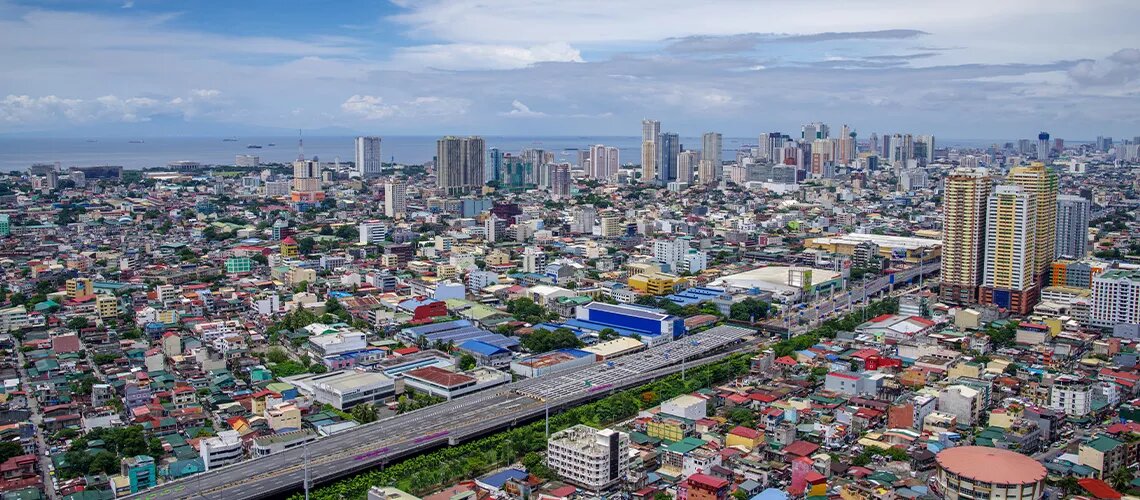Seismic resilience in Metro Manila: Accessing healthcare after a catastrophic earthquake on the West Valley Fault line
Originally published on World Bank Blogs on 28 March 2024
Authors:
- Jun Rentschler, Senior Economist
- Christoph Klaiber, Consultant, World Bank’s Global Facility for Disaster Reduction and Recovery (GFDRR)
- Artessa Saldivar-Sali, Resilience Engineering Specialist, World Bank
- Elad Shenfeld, Senior Disaster Risk Management Specialist
 Aerial view of metro Manila
Aerial view of metro Manila
On April 22, 2019, a 6.1 magnitude earthquake shook the island of Luzon in the Philippines—the fourth most populated island in the world, causing multiple deaths and injuring many more people. The epicenter was 82km northwest of Metro Manila, which saw a few buildings tilting due to soil liquefaction—but escaped more severe damages that day.
Metro Manila—one of the largest economic hubs in Southeast Asia—is the economic powerhouse of the Philippines, home to roughly 11% of the country’s population and contributing 32% of the national GDP. Metro Manila escaped relatively unscathed in 2019, but a larger risk is looming in the background: the threat of a major earthquake along the West Valley Fault (WVF, Map 1), which runs directly underneath the metropolitan area and poses the most serious threat out of the multiple earthquake generators transecting Metro Manila.

Potential Impacts
A Metro Manila risk assessment estimated that a magnitude 7.2 earthquake on the WVF (a probable maximum scenario, so-called "The Big One"), could result in an estimated 48,000 fatalities, and $48 billion in economic losses. It also poses a severe threat to urban mobility in the metropolitan area and the provision of key public services, including the health system, as well as lifeline infrastructure like water and energy supply.
Hospitals and the health system play a crucial role in the direct aftermath of an earthquake. Operational facilities are necessary for government continuity plans and for meeting surge demand caused by an earthquake, while simultaneously continuing to provide the baseline services needed by everyday patients and people with preexisting health conditions—a population group with heightened vulnerability to begin with. The ability of such facilities to provide critical care depends on their ability to withstand the seismic shock, but also on being accessible once transport infrastructure is hit.
Accessibility analysis
To assess the risk and enable strategic preparations, as part of the Philippines Seismic Risk Reduction and Resilience Project we analyzed seismic risks in Metro Manila using government data on soil liquefaction (i.e. earthquake-related ground deformation), hospital locations, transport networks, and estimated disruptions to urban mobility. Map 2 shows the location of roads exposed to liquefaction in case of an earthquake from the WVF. However, liquefaction and ground deformation are to be expected, as well as ground shaking. Around 5,300 road segments directly cross the WVF—and in the event of an earthquake they would incur significant damage and may become impassable. As a result, people may not be able to access critical public services and jobs, while the government may be prevented from effectively responding to the emergency.
Our analysis suggests that in the case of a WVF earthquake, over 7,000 km of roads—roughly 34 percent of Metro Manila’s road network—could be affected by liquefaction, causing ground deformation and obstructing roadways. Access times to health facilities increase significantly compared to baseline nonpeak traffic. On average, across all of Metro Manila, access times increase by about 148% (Map 3). In several locations affected by liquefaction, access times could be ten times longer, thus effectively cutting people off. Map 3 highlights the locations in Metro Manila with the largest increases in access time. Figure 1 summarizes these numbers. The results also suggest that in the post-earthquake scenario, hospital access by ambulance would now exceed one hour for almost 10% of the population of Metro Manila (or 1.1 million people) – compared to 0.7% in the baseline scenario.

Preparing for "The Big One"
To minimize the impacts of an earthquake, investing in preparedness and response systems is key. Targeting critical road segments and neighborhoods for emergency preparedness and response investments can accelerate recovery times and strengthen people’s access to essential public services during a disaster and in its immediate aftermath. This is the objective of the World Bank’s Philippines Seismic Risk Reduction and Resilience Project. To strengthen the city’s resilience to earthquakes and other disasters, it retrofits buildings of high public importance, enhances the preparedness and response capacity of key government agencies, and strategically positions emergency response capabilities to access critical services. Based on a seismic vulnerability assessment, 425 public buildings including health facilities and schools are being upgraded. Furthermore, emergency preparedness is increased through planning transport and mobility restoration and improving crisis communication and information management. This helps strengthen the capacity of the Department of Public Works and Highways (DPWH) to respond to emergencies and provide essential support after a disaster.
Disasters like the earthquake on April 22, 2019, have underscored the urgent need to prepare Metro Manila for earthquakes with epicenters closer to the city. Through this project, the Philippine government is doing just that, by actively increasing the resilience and safety of the population and proactively strengthening its disaster preparedness.
This work is part of the Thematic Area on Climate and Disaster Risk Management for Health Systems at the World Bank’s Global Facility for Disaster Reduction and Recovery (GFDRR), which is funded by the Japan-World Bank Program on Mainstreaming DRM in Developing Countries. The Program collaborates with World Bank teams to assist governments with building more resilient healthcare.
Retrieved from https://blogs.worldbank.org/sustainablecities/seismic-resilience-metro-manila-accessing-healthcare-after-catastrophic
